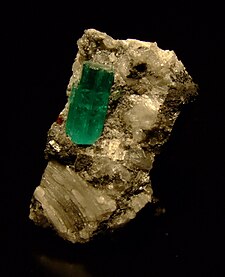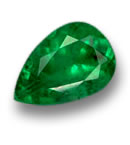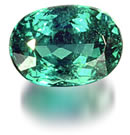Etymology
[edit]Properties determining value
Emeralds, like all colored
gemstones, are graded using four basic parameters – the four Cs of Connoisseurship:
Color,
Cut,
Clarity and
Crystal. The last C,
crystal is simply used as a synonym that begins with C for transparency or what
gemologists call
diaphaneity. Before the 20th century, jewelers used the term
water as in "a gem of the finest water"
[3] to express the combination of two qualities, color and crystal. Normally, in the grading of colored gemstones, color is by far the most important criterion. However, in the grading of emerald, crystal is considered a close second. Both are necessary conditions. A fine emerald must possess not only a pure verdant green
hue as described below, but also a high degree of
transparency to be considered a top gem.
[4]
In the 1960s the American jewelry industry changed the definition of 'emerald' to include the green vanadium-bearing beryl as emerald. As a result,
vanadium emeralds purchased as emeralds in the United States are not recognized as such in the UK and Europe. In America, the distinction between traditional emeralds and the new vanadium kind is often reflected in the use of terms such as 'Colombian Emerald.'
[5]
Scientifically speaking, color is divided into three components:
hue,
saturation and
tone. Emeralds occur in hues ranging from yellow-green to blue-green, with the primary hue necessarily being green. Yellow and blue are the normal secondary hues found in emeralds. Only gems that are medium to dark in tone are considered emerald; light-toned gems are known instead by the species name
green beryl. The finest emerald are approximately 75% tone on a scale where 0% tone would be colorless and 100% would be opaque black.
[6] In addition, a fine stone should be well saturated, the hue of an emerald should be bright (vivid). Gray is the normal saturation modifier or mask found in emerald; a grayish-green hue is a dull green hue.
[7]
Emeralds are green by definition (the name is derived from the Greek word 'smaragdus', meaning green).
[8] Emeralds are the green variety of
beryl, a mineral which comes in many other colors that are sometimes also used as gems, such as blue
aquamarine, yellow
heliodor, pink
morganite and colorless
goshenite.
[9]
[edit]Clarity
Emerald tends to have numerous inclusions and surface breaking
fissures. Unlike diamond, where the
loupe standard, i.e. 10X magnification, is used to grade clarity, emerald is graded by eye. Thus, if an emerald has no visible
inclusions to the eye (assuming normal visual acuity) it is considered flawless. Stones that lack surface breaking fissures are extremely rare and therefore almost all emeralds are treated, "oiled", to enhance the apparent clarity. Eye-clean stones of a vivid primary green hue (as described above) with no more than 15% of any secondary hue or combination (either blue or yellow) of a medium-dark tone command the highest prices.
[4] This relative crystal non-uniformity makes emeralds more likely than other gemstones to be cut into
cabochons, rather than faceted shapes.
[edit]Treatments
Most emeralds are oiled as part of the post
lapidary process, in order to improve their clarity.
Cedar oil, having a similar
refractive index, is often used in this generally accepted practice. Other liquids, including synthetic oils and polymers with refractive indexes close to that of emerald such as
Opticon are also used. The
U.S. Federal Trade Commission requires the disclosure of this treatment when a treated emerald is sold.
[10] The use of oil is traditional and largely accepted by the gem trade. Other treatments, for example the use of green-tinted oil, are not acceptable in the trade. The laboratory community has recently standardized the language for grading the clarity of emeralds. Gems are graded on a four step scale;
none,
minor,
moderate and
highly enhanced. Note that these categories reflect levels of enhancement not
clarity. A gem graded
none on the enhancement scale may still exhibit visible inclusions. Laboratories tend to apply these criteria differently. Some gem labs consider the mere presence of oil or polymers to constitute enhancement. Others may ignore traces of oil if the presence of the material does not materially improve the look of the gemstone.
Given that the vast majority of all emeralds are treated as described above, and the fact that two stones that appear visually similar may actually be quite far apart in treatment level and therefore in value, a consumer considering a purchase of an expensive emerald is well advised to insist upon a treatment report from a reputable gemological laboratory. All other factors being equal, a high quality emerald with an enhancement level of moderate should cost half an identical stone graded none.
[4]
[edit]Emerald localities
A rare type of emerald known as a
trapiche emerald is occasionally found in the mines of
Colombia. A trapiche emerald exhibits a "star" pattern; it has raylike spokes of dark carbon impurities that give the emerald a
six-pointed radial pattern.
[citation needed]Emeralds come from three main emerald mining areas in Colombia:
Muzo, Coscuez, and
Chivor.
[12]
Colombia is by far the worlds largest producer of emeralds, constituting 50-95% of the world production, with the number depending on the year, source and emeralds grade.
[13][14][15][16] Emerald production in Colombia has increased drastically in the last decade, increasing by 78% in 2010 compared to production in 2000.
[17]
The emerald deposits of
Zambia in the Kafubu River (Kagem Mines),about 45 km southwest of Kitwe, produced around 20% of world production of gem quality emeralds in 2004, making the Kafubu area mines the second in world wide production after Colombia.
[18] In the first 6 months of 2011 Kagem mines produced 3.74 tons of emeralds.
[19] Zambian emeralds have very high quality, they are less porous and less brittle than Colombian emeralds, with more even color.
Emeralds are also found in other countries, such as
Afghanistan,
Australia, Austria,
Brazil,
[20] Bulgaria,
Cambodia,
Canada,
China,
Egypt,
Ethiopia,
France,
Germany,
India,
Italy,
Kazakhstan,
Madagascar,
Mozambique,
Namibia,
Nigeria,
Norway,
Pakistan,
Russia,
Somalia,
South Africa,
Spain,
Switzerland,
Tanzania,
United States,
Zambia and
Zimbabwe.
[1] In the US, emeralds have been found in
Connecticut,
Montana,
Nevada,
North Carolina and
South Carolina.
[1] In 1998 emeralds were discovered in the
Yukon.
[citation needed]
[edit]Synthetic emerald

Emerald showing its hexagonal structure
Emerald is a rare and valuable gemstone and, as such, it has provided the
incentive for developing synthetic emeralds. Both hydrothermal and
flux-growth synthetics have been produced, and a method has been developed for producing an emerald overgrowth on colorless
beryl. The first commercially successful emerald synthesis process was that of
Carroll Chatham. Because Chatham's emeralds do not have any water and contain traces of vanadate, molybdenum and vanadium, a lithium vanadate flux process is probably involved. The other large producer of flux emeralds was
Pierre Gilson Sr., which has been on the market since 1964. Gilson's emeralds are usually grown on natural colorless beryl seeds which become coated on both sides. Growth occurs at the rate of 1 mm per month, a typical seven-month growth run producing emerald crystals of 7 mm of thickness.
[21] Gilson sold his production laboratory to a Japanese firm in the 1980s, but production has ceased since; so did Chatham's, after the
1989 San Francisco earthquake.
Hydrothermal synthetic emeralds have been attributed to
IG Farben, Nacken,
Tairus, and others, but the first satisfactory commercial product was that of
Johann Lechleitner of
Innsbruck,
Austria, which appeared on the market in the 1960s. These stones were initially sold under the names "Emerita" and "Symeralds", and they were grown as a thin layer of emerald on top of natural colorless beryl stones. Although not much is known about the original process, it is assumed that Leichleitner emeralds were grown in acid conditions.
[citation needed] Later, from 1965 to 1970, the
Linde Division of
Union Carbide produced completely synthetic emeralds by hydrothermal synthesis. According to their patents,
[22][23] acidic conditions are essential to prevent the chromium (which is used as the colorant) from precipitating. Also, it is important that the silicon-containing nutrient be kept away from the other ingredients to prevent nucleation and confine growth to the seed crystals. Growth occurs by a diffusion-reaction process, assisted by convection. The largest producer of hydrothermal emeralds today is
Tairus in Russia. They have succeeded in synthesizing emeralds that have similar chemical composition as emeralds in alkaline deposits in Colombia, hence they are called “Colombian Created Emeralds” or “Tairus Created Emeralds”.
[24] Luminescence in
ultraviolet light is considered a supplementary test when making a natural vs. synthetic determination, as many, but not all, natural emeralds are inert to ultraviolet light. Many synthetics are also UV inert.
[25]
Synthetic emeralds are often referred to as "created", as their chemical and gemological composition is the same as their natural counterparts. The
U.S. Federal Trade Commission (FTC) has very strict regulations as to what can and what cannot be called "synthetic" stone. The FTC says: "§ 23.23(c) It is unfair or deceptive to use the word "laboratory-grown," "laboratory-created," "[manufacturer name]-created," or "synthetic" with the name of any natural stone to describe any industry product unless such industry product has essentially the same optical, physical, and chemical properties as the stone named."
[26]
[edit]Emerald in different cultures, and emerald lore
Emerald is regarded as the traditional
birthstone for May, as well as the traditional gemstone for the
astrological signs of
Taurus,
Cancer and sometimes
Gemini. One of the quainter anecdotes on emeralds was by the 16th-century historian
Brantôme, who referred to the many impressive emeralds the Spanish under
Cortez had brought back to Europe from Latin America. On one of Cortez's most notable emeralds he had the
text engravedInter Natos Mulierum non sur-rexit mayor ("Among those born of woman there hath not arisen a greater,"
Matthew 11:11) which referred to
John the Baptist. Brantôme considered engraving such a beautiful and simple product of nature sacrilegious and considered this act the cause for Cortez's loss of an extremely precious pearl (to which he dedicated a work,
A beautiful and incomparable pearl), and even for the death of King
Charles IX of France, who died soon after.
[27] "
The Attenbury Emeralds" is a detective story in which
Lord Peter Wimsey must solve several emerald-related mysteries.
 Emerald crystal from Muzo, Colombia
Emerald crystal from Muzo, Colombia
Gallery
-
The
Chalk Emerald ring, containing a top-quality 37-carat emerald, also in the U.S. National Museum of Natural History.
The
Hooker Emerald Brooch, containing a 75-carat square-cut emerald, also in the U.S. National Museum of Natural History.
Emerald crystal (about 1 cm) in
calcite matrix,
Muzo, Colombia.
-
Typical low quality emerald.




















